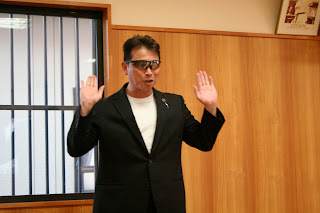
Peter Here,
Because of having to work, I think I might be the first Intern to have not completed the Senbonzuki (1,000 punch) practice. I must say, I’m more than a little sad about it, as I was really looking forward to the challenge. However, such is life in Japan- if you are contracted to work, there’s little you can do (enter that handy “shooganai” – ‘it can’t be helped’ - phrase again).
Instead of training, it was the final English class for ICE in Nerima on Thursday 23rd December. We had a party for all the kids where we played English games and ate lots of unhealthy cakes and sweets (it is the season after all!).
I was asked to prepare the games, so I made a bingo sheet based upon the vocabulary I taught this year, then Pictionary (drawing what is on a flash card for others to guess), and finally Twister. Even though I missed training because of it, I had a very good time and Oguchi Sensei and my adult student Kondo san even gave me presents! It was very unexpected!
The Shiramizu English Club party was the next day-Christmas Eve! All English students were invited, but some couldn’t come because of school (it’s almost unthinkable to me that some kids are still at school on Christmas eve, and even Christmas Day!), but there were enough there to have fun!
First up was an English lesson – this was a bit difficult because of the difference in abilities between the kid's ages, but after changing the lesson into a learning game, they soon all became interested. Well, at least as interested as kids get when being taught at a party!

Second was ‘Magician Arakawa’, performing mighty feats of magic under a lot of pressure from a tough crowd!



After a small break of food and ball games, we had another special guest... Black Belt Santa San! Before giving the kids presents for being good he reminded everyone of the virtues of studying and practising hard. Obviously his schedule was very busy for the day so it was a quick visit. It was a shame Arakawa Sensei was somehow occupied while here was here though!

In the evening, Arakawa Sensei, his family and I went out to a steak house for dinner- this has happened with almost every Intern on Christmas Eve since Mark was the intern, so I’m glad to have kept the tradition. It was also great to just talk and relax and ask Masatoshi about what he wants for Christmas, and what Sensei’s plans were for Christmas and the New Year.
With my work duties done for the year, the rest of 2010 was spent relaxing, training when I can and making sure my toe recovers as quickly as possible.


















































